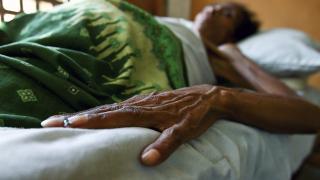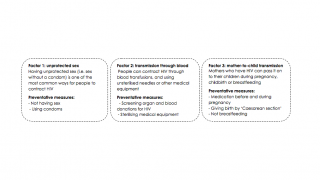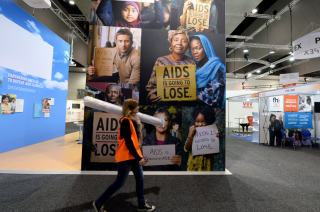HIV/AIDS is one of the most pressing issues for world leaders to tackle. Since it was recognised as a virus in 1981, HIV and its related disease AIDS are estimated to have killed more than 35 million people worldwide. While some regions of the world are affected more than others, HIV/AIDS claims lives in all areas: in the UK, over 98,000 people have been diagnosed – a figure that has trebled in the last decade.
World AIDS Day, commemorated each year on 1 December, is one way in which the UN aims to raise awareness of this deadly disease and to encourage governments and people all over world to take action. The photo above shows the inside of Melbourne Convention Centre, which hosted a conference on AIDS in 2014 (UNAIDS).
What is HIV/AIDS?
Although they are often written together as above, HIV and AIDS are not the same thing.
>> HIV stands for Human Immonudeficiency Virus.
Like all viruses, HIV cannot grow or reproduce on its own. In order to make new copies of itself it must infect the cells of a living organism. The human immune system, which protects our bodies, usually finds and kills viruses, but HIV attacks the immune system itself – the very thing that would normally get rid of a virus. People can live with HIV for many years without getting sick.
>> AIDS is a disease caused by HIV. The acronym stands for:
- Acquired – meaning you can get infected with it
- Immune Deficiency – meaning a weakness in the body’s system that fights diseases
- Syndrome – meaning a group of health problems that make up a disease
A person is considered to have developed AIDS when their immune system is so weak it can no longer fight off viruses, parasites, bacteria and diseases with which it would normally cope.

Living with HIV/AIDS
There is no cure for HIV/AIDS. However, recent improvements in the quality and distribution of medical treatments, known as antiretroviral therapy (ART), mean that people who have contracted the virus can now lead longer and more normal lives.
While initially too expensive for patients in poorer countries, global action and campaigning has made ART more widely available. Kofi Annan, the former UN Secretary-General, played a key role in convincing major pharmaceutical companies to reduce the costs of antiretroviral drugs.
By the end of 2012, some 9.7 million people in low- and middle-income countries such as Brazil, Cambodia and Zambia were accessing antiretrovirals. According to the World Health Organization, wider access to ART helped avert 4.2 million deaths in low and middle-income countries in the period between 2002 and 2012.
Research has also shown that ART prevents the onward transmission of HIV. While it was estimated that 3.3 million children under the age of 15 were living with HIV in 2012, there was a 35 per cent decline in new HIV infections among this group compared with 2009.
This was mainly a result of more pregnant women living with HIV being given access to ART and a stronger focus on the long-term health of these women.
Who is affected and how?
While the majority of people infected with HIV live in sub-Saharan Africa, all regions are affected by the virus and new infections are particularly on the rise in Eastern Europe and Central Asia. Although the total number of people living with HIV/AIDS is still increasing, the number of new infections has been reduced by 33 percent since 2001.
Many people do not understand that anybody – young, old, poor, rich, male or female – can catch the virus. There is also confusion about how people become infected with HIV. It is perfectly safe to touch, shake hands with or use the same toilet or swimming pool as a person who is infected with HIV.
Understanding how people become infected is essential in order to work out how what can be done to prevent the spread of AIDS:

HIV/AIDS affects people in a variety of ways. The physical impact of the virus can mean that people are unable to work or care for their families. Even children who do not have HIV/AIDS can suffer: over 17 million children in the world have lost one or both parents to the virus.
People living with HIV/AIDS can also be subjected to discrimination, social exclusion and even violence because of their illness. They might also experience strained relationships with their family and friends.

As HIV/AIDS prevention and treatment involves many things – such as providing healthcare, improving education and fighting discrimination – many different parts of the United Nations work together on this issue.
In order to make sure HIV/AIDS remains a priority, the UN has appointed a dedicated organisation called UNAIDS to coordinate its efforts. The picture shows the Executive Director of UNAIDS, Michael Sidibé, joining people at an HIV community event in Austrialia for World AIDS Day 2014.
Combating HIV/AIDs has been an important part of the Millennium Development Goals (MDGs), the UN largest anti-poverty initiative, which had specific targets on halting and reversing the spread of the disease and provide universal access to treatment.
The initiative has helped to put the spotlight on HIV/AIDS, leading to more investment and greater commitment by political leaders to tackle this issue.
Building on this momentum , UNAIDS is now working toward the vision of “Zero new HIV infections, Zero discrimination, Zero AIDS-related deaths".
As part of its Getting to Zero strategy, UNAIDS continues to work to strengthen HIV prevention, further improve access to and quality of treatment and promote the human rights of people living with HIV.
This includes addressing the continued discrimination and social exclusion of vulnerable groups such as sex workers, drug users and homosexuals which can prevent such groups from accessing prevention and treatment programmes.

